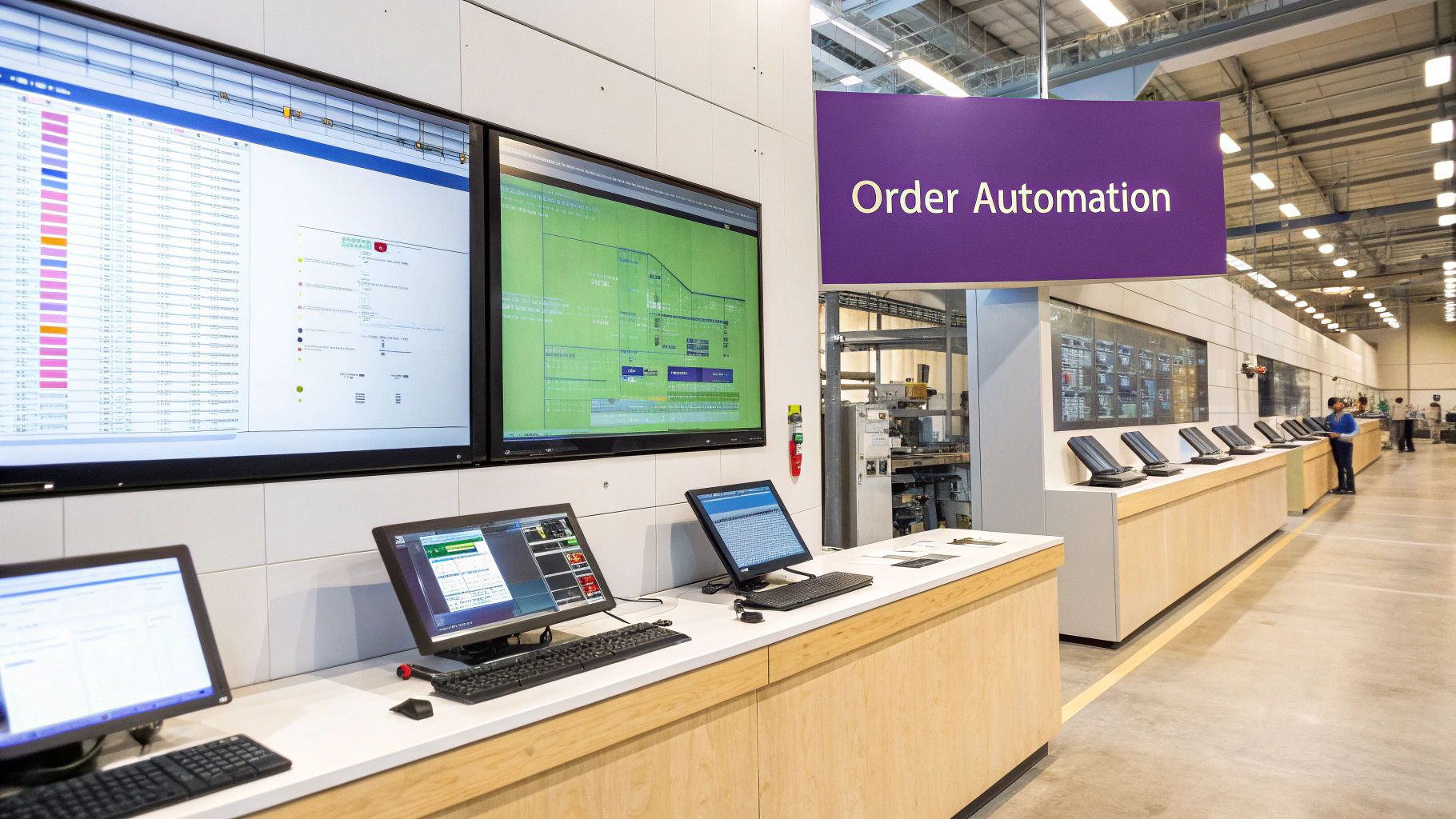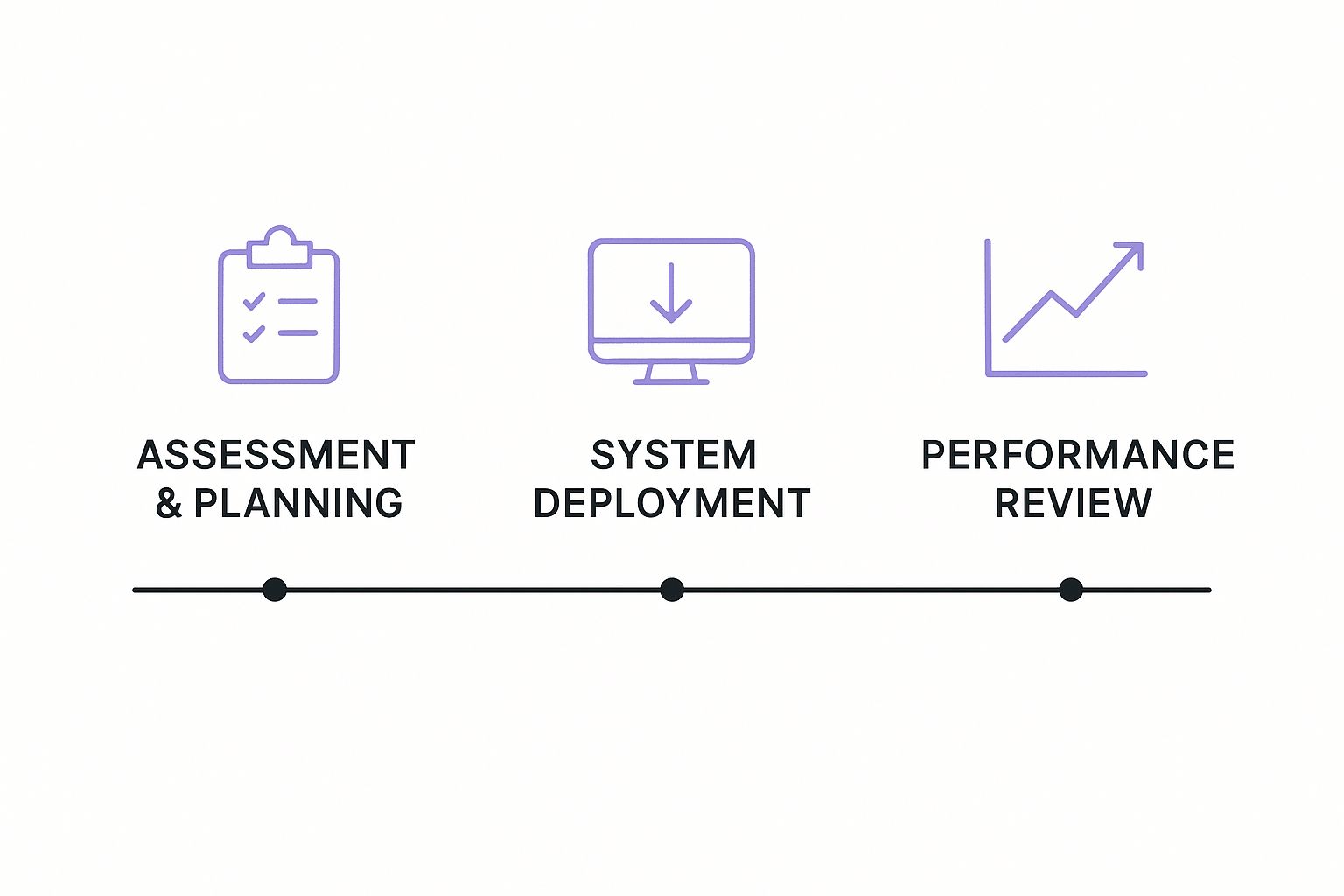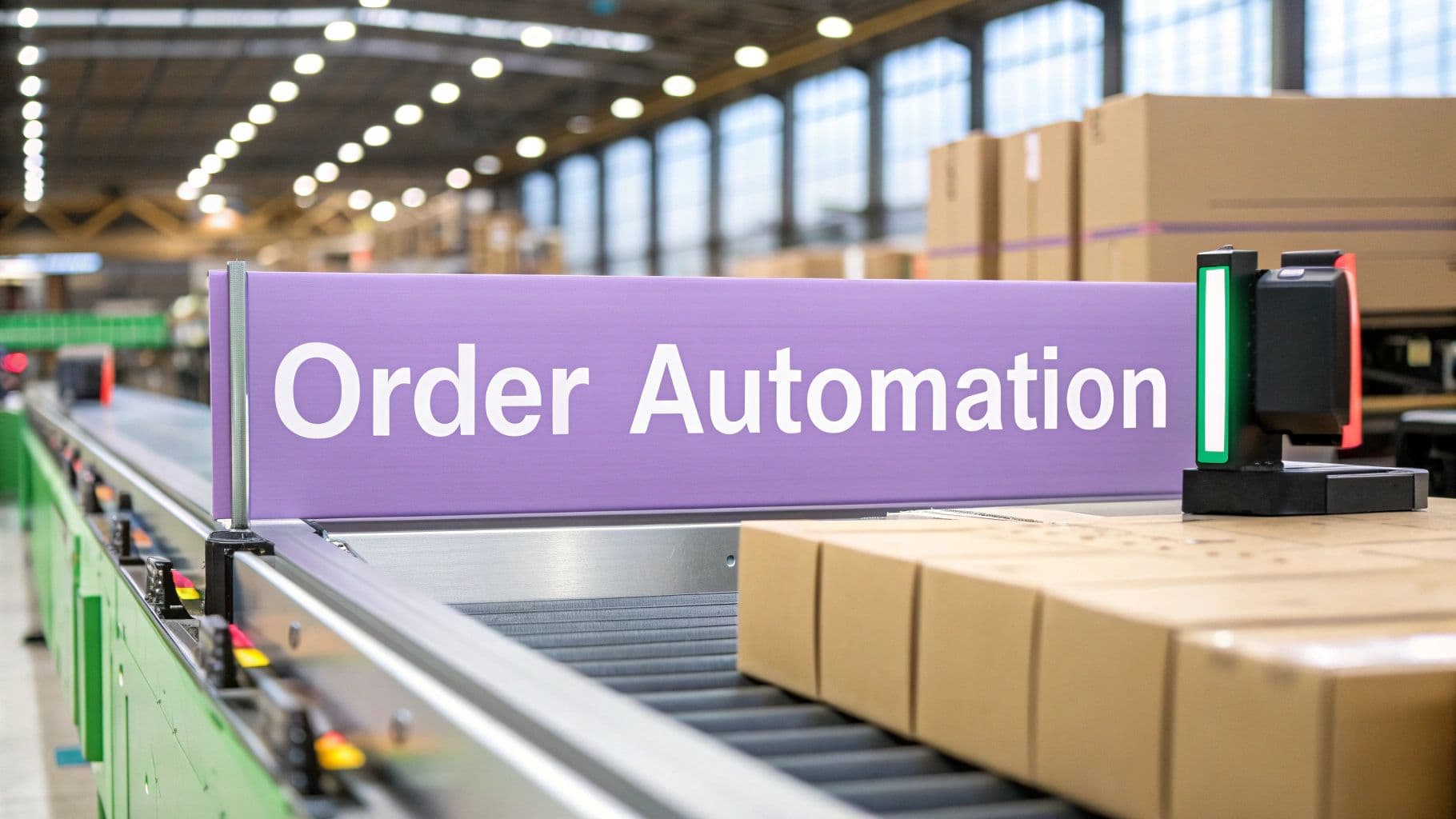Why Order Management Automation Is Transforming Business

Manual order processing acts as a significant roadblock for many businesses. For actionable tips on workflow automation for small business, explore our comprehensive guide. It's like navigating rush hour traffic through a single, congested lane – slow, inefficient, and prone to errors. Order management automation, on the other hand, provides a multi-lane highway solution, optimizing the entire process from initial order placement to final fulfillment. This eliminates tedious manual data entry, reduces costly mistakes, and fosters seamless information sharing between sales and fulfillment teams.
The Impact on Efficiency and Growth
Imagine a business handling hundreds of orders daily. Manually inputting data, tracking shipments, and managing inventory can quickly overwhelm staff and lead to inaccuracies. Automation takes over these repetitive tasks. This frees up valuable employee time to focus on more strategic activities, such as customer relationship management and long-term planning. Businesses can scale their operations without needing a proportionally larger workforce.
Automation also provides real-time insights into every stage of the order lifecycle, allowing for proactive issue management. It's like having a smart traffic management system that anticipates congestion and reroutes traffic smoothly. This level of visibility is crucial for maintaining efficiency and minimizing disruptions.
Real-World Results and Market Trends
The advantages of order management automation extend beyond internal operations, directly impacting customer satisfaction. Faster processing, accurate fulfillment, and proactive communication build trust and foster customer loyalty. This move toward automation is not a fleeting trend; it's a fundamental shift in business operations.
The global order management systems (OMS) market is experiencing significant growth, projected to reach USD 1.9 billion in the near future. This represents a compound annual growth rate (CAGR) of approximately 12.3%. This rapid expansion is driven by the increasing demand for automation and optimized supply chains, particularly with the rise of distributed order management software. This type of software empowers businesses to efficiently manage orders from various channels. For deeper insights into this market, explore these statistics: Learn more about retail distributed order management systems statistics. Platforms like WordPress can also be valuable resources for understanding online business practices.
Overcoming Resistance to Change
Implementing order management automation does come with its own set of challenges. Some employees may resist change due to concerns about job security or the perceived difficulty of learning new systems. Successfully managing this transition requires clear and open communication, comprehensive training programs, and highlighting the long-term benefits of automation for both the business and its employees. Embracing order management automation is no longer optional; it's a necessity for businesses striving to succeed in today’s competitive landscape.
The Building Blocks of Order Management That Actually Works

Effective order management automation hinges on several interconnected components working together, much like a well-oiled machine. This synergy leads to a better customer experience and significant boosts in efficiency.
Intelligent Order Capture
The foundation of any successful automated system is intelligent order capture. This involves automatically gathering order data from various sales channels – your website, online marketplaces, or even phone orders.
This automation eliminates manual data entry, a common source of errors and delays. It ensures orders are processed quickly and accurately right from the beginning.
Real-Time Inventory Visibility
Real-time inventory visibility is another critical piece of the puzzle. Imagine knowing your exact stock levels across all locations, at any given time.
This prevents overselling and backorders, allowing for accurate order promises. This directly improves customer satisfaction and reduces operational issues.
Seamless Order Routing and Fulfillment
Once an order is captured and inventory confirmed, seamless order routing comes into play. This involves automatically sending the order to the best fulfillment location.
Automated systems consider factors like customer proximity and stock availability to ensure fast, cost-effective delivery, optimizing fulfillment times and minimizing shipping costs.
Streamlined Communication and Notifications
Effective order management automation also incorporates streamlined communication. Automated notifications keep customers informed at every stage of their order.
This proactive communication builds trust and enhances the customer experience. Automated systems can also alert staff to potential problems, enabling quick solutions.
Integration and Compatibility
All these components must integrate seamlessly. This requires careful consideration of your tech stack compatibility. Your order management system should integrate with your existing CRM, ERP, and other critical software.
This integration eliminates data silos and ensures smooth information flow across your organization, fostering efficiency and informed decision-making. For further insights into automation's business impact, explore Ecommerce Marketing Automation Strategies.
To help visualize the core components and their impact, let's look at the following table:
To understand the core components within order management automation and their impact on the business, the following table offers a detailed breakdown.
| Component | Primary Function | Business Impact | Integration Complexity |
|---|---|---|---|
| Intelligent Order Capture | Automates order data collection from various channels | Reduces errors, speeds up processing, improves order accuracy | Low |
| Real-Time Inventory Visibility | Provides up-to-the-minute stock information | Prevents overselling, minimizes backorders, enables accurate order promising | Medium |
| Seamless Order Routing | Directs orders to the optimal fulfillment location | Optimizes fulfillment times, reduces shipping costs, improves delivery efficiency | Medium |
| Streamlined Communication | Automates customer and staff notifications | Enhances customer experience, allows for proactive issue resolution | Low |
In conclusion, this table illustrates how each component contributes to a more efficient and customer-centric order management process. By building upon these essential elements, businesses can create an effective order management automation system that significantly improves efficiency, customer satisfaction, and profitability.
Warehouse Automation: The Missing Piece in Order Excellence

Order management automation software is a powerful tool. Its true potential, however, is unlocked when combined with a streamlined warehouse operation. Imagine having the most advanced ordering system, but a disorganized warehouse. Fulfilling orders quickly and accurately becomes a significant hurdle. This section explores the critical connection between digital order management and the physical fulfillment process.
Bridging the Gap Between Digital and Physical
Integrating order management software with warehouse automation creates a powerful synergy. When orders are received, automated systems can instantly initiate fulfillment. This includes picking, packing, and shipping with minimal human involvement. This speed and efficiency are essential for meeting customer expectations in today’s competitive market.
For example, consider a customer ordering a product online. With integrated systems, the order details are immediately transmitted to the warehouse. Automated systems then locate the item, package it, and prepare it for shipment. This significantly reduces fulfillment time. This seamless process eliminates manual tasks, reducing errors and allowing staff to focus on more complex activities.
Technologies Driving Warehouse Efficiency
Several technologies are transforming warehouse operations. Smart picking systems guide workers directly to the correct location, minimizing search time and errors. Automated storage and retrieval systems (AS/RS) optimize storage space and accelerate retrieval times. AI-driven inventory placement anticipates demand and strategically positions popular items for faster access. These advancements go beyond robots and conveyors. They create a smarter, more responsive warehouse that ultimately improves efficiency and cuts costs.
Warehouse automation, closely linked to order management automation, is reshaping logistics and supply chain efficiency worldwide. The global warehouse automation market, valued at roughly USD 26.5 billion in 2024, is projected to grow at a CAGR of 15.9% from 2025 to 2034. This growth is driven by advancements in AI, robotics, and AS/RS, enhancing inventory management and order fulfillment. Explore this topic further.
Overcoming Implementation Challenges and Resistance
Implementing these systems can present difficulties. Warehouse teams might resist change. Successful implementations, however, often involve thorough planning, transparent communication, and robust training programs. This helps address concerns and ensures a smooth transition. Actively involving warehouse staff in the planning process can also foster a sense of ownership and encourage acceptance.
The Power of Visibility
Beyond physical automation, integrated systems offer invaluable visibility. Real-time data on inventory levels, order status, and potential bottlenecks allows for proactive problem-solving. This shifts customer communication from reactive apologies to proactive updates, building trust and confidence. This transparency empowers businesses to anticipate potential problems and make data-driven decisions, preventing issues before they affect customers.
By combining order management automation with warehouse automation, businesses can establish a truly efficient and customer-focused fulfillment process. This integration not only streamlines operations but also strengthens customer relationships and fuels overall business growth.
Implementation Roadmap: Avoiding Costly Mistakes

This infographic illustrates the three core stages of successfully implementing order management automation: Assessment & Planning, System Deployment, and Performance Review. Each stage is essential for lasting success. The visual emphasizes the sequential and interconnected nature of these phases, highlighting the benefits of a structured approach.
Successfully automating your order management isn't simply about selecting the right software. It's about a well-defined plan that minimizes disruptions and maximizes your return on investment. This section offers a practical roadmap based on insights from companies that have successfully implemented these systems.
Pre-Implementation Assessment: Identifying Your Pain Points
Before you even start looking at vendors, a comprehensive pre-implementation assessment is crucial. This means identifying your specific pain points. Are manual data entry errors a constant struggle? Are slow order processing times affecting customer satisfaction? This assessment goes beyond surface issues to uncover the root causes affecting your efficiency.
For instance, a company might identify slow order fulfillment as a problem. But, a deeper look could reveal inefficient warehouse organization, not the order management system itself, is the main bottleneck. This understanding allows for solutions that truly address the core problem.
Choosing the Right Vendor: Avoiding Regret
Once you have a clear understanding of your needs, a structured decision framework is essential for selecting the right vendor. This framework goes beyond compelling sales pitches and focuses on practical factors like system compatibility, scalability, and vendor support. Choosing the right partner is a critical decision.
Consider a fast-growing e-commerce business. Choosing a system that can't handle increasing order volume would be an expensive mistake. This underscores the importance of aligning your choice with your future growth plans.
Phased Rollout: Maintaining Business Continuity
Implementing new systems can disrupt daily operations. A phased rollout strategy mitigates this risk. Start by implementing the system within a limited scope, such as a single department or product line. This allows for testing and adjustments before a full-scale deployment, minimizing disruptions and allowing teams to adapt gradually.
Change Management: Winning Staff Buy-In
Many organizations underestimate the importance of change management. Implementing new technology requires staff training and ongoing support. This is not just an IT project; it's an organizational change.
Successful implementations involve staff from the beginning, addressing their concerns and providing adequate training. This fosters confidence and encourages adoption of the new system.
Realistic Timelines and Metrics
Implementation timelines vary based on company size and complexity. A smaller business might implement a system in a few months, while larger enterprises might need a year or more. Establishing realistic timelines prevents unrealistic expectations and reduces unnecessary pressure.
Moreover, defining critical success metrics, such as reducing order processing time or decreasing error rates, provides a tangible way to measure progress and demonstrate ROI. These metrics should guide the project from initial vendor selection to final deployment.
To help visualize the typical implementation process, the following table outlines key phases and estimated durations:
Order Management Automation Implementation Timeline This table outlines the typical phases of implementing order management automation and estimated timeframes.
| Implementation Phase | Key Activities | Typical Duration | Critical Success Factors |
|---|---|---|---|
| Pre-Implementation Assessment | Needs analysis, pain point identification, workflow mapping | 2-4 weeks | Stakeholder engagement, thorough documentation |
| Vendor Selection | Requirements gathering, RFP process, vendor demos and evaluations | 4-8 weeks | Clear criteria, cross-functional team involvement |
| System Configuration and Customization | System setup, data migration, integration with existing systems | 8-12 weeks | Dedicated project team, rigorous testing |
| Training and Change Management | User training, documentation development, go-live support | 2-4 weeks | Comprehensive training materials, ongoing support |
| Deployment and Go-Live | Phased rollout, system monitoring, issue resolution | 4-6 weeks | Detailed deployment plan, proactive communication |
| Post-Implementation Review | Performance monitoring, system optimization, ROI analysis | Ongoing | Defined metrics, continuous improvement |
This table offers a general framework. Specific timelines and activities will vary depending on the individual organization and the chosen order management system. However, understanding these phases and focusing on the critical success factors outlined can significantly contribute to a smoother, more successful implementation.
Measuring What Matters: The Real ROI Metrics
Implementing order management automation requires an investment. So, how can you measure the return and demonstrate its value? Beyond vendor promises, what metrics truly reflect success? This section explores the key performance indicators (KPIs) that quantify the impact of automation.
Quantifying the Hard Benefits
The most tangible benefits are the hard benefits: those easily quantifiable and directly impacting the bottom line.
-
Processing Cost Reduction: Automation reduces manual labor costs associated with order entry, tracking, and processing. Calculate the time saved per order multiplied by the previous hourly wage for these tasks.
-
Error Elimination: Manual processes are prone to errors. Automation significantly reduces these, leading to fewer returns, refunds, and customer service inquiries. Track the reduction in error-related costs after implementation.
-
Order Cycle Time: This measures the time from order placement to fulfillment. Automation typically shortens this cycle. A shorter cycle means faster delivery, happier customers, and potentially increased sales.
These hard benefits offer early validation of your automation investment and justify continued investment.
Recognizing the Soft Advantages
While harder to quantify, the soft advantages are equally valuable.
-
Improved Customer Satisfaction: Faster processing, accurate fulfillment, and proactive communication lead to happier customers. Track customer satisfaction scores and reviews after automation.
-
Increased Team Morale: Freeing employees from repetitive tasks allows them to focus on more engaging work. This boosts morale and reduces employee turnover.
-
Enhanced Scalability: Automation allows your business to handle increased order volume without a proportionally larger staff. This scalability is crucial for growth.
These soft advantages contribute to a more positive work environment and lay the groundwork for long-term success. Happier customers lead to greater loyalty and repeat business, indirectly impacting revenue.
Building a Compelling Business Case
Leading companies use both hard and soft benefits to build compelling business cases for continued investment in order management automation. They track progress from initial implementation through long-term transformation. This detailed tracking demonstrates not just initial gains, but the ongoing value.
Business automation in order management is a key factor driving growth and operational efficiency. The marketing automation market, a subset of the broader automation landscape, was projected to grow to an estimated USD 14.55 billion by 2031, reflecting a CAGR of 12.55%. This increasing reliance on technology underscores the importance of automation in streamlining functions like order management. Find more detailed statistics here.
By focusing on these metrics, businesses can clearly demonstrate the value of order management automation, justifying initial investment and securing ongoing resources for optimization and expansion. This data-driven approach ensures the automation strategy aligns with business objectives and delivers maximum impact.
What's Next: Order Management Automation on the Horizon
The order management landscape is always changing. Systems considered advanced today might be obsolete tomorrow. This section explores emerging trends set to reshape order management automation, offering a glimpse into the future.
AI-Powered Predictive Capabilities
Artificial intelligence (AI) is progressing beyond simple automation. It's developing predictive capabilities to anticipate customer needs and proactively address potential fulfillment problems. Imagine AI analyzing past order data to predict future demand, optimizing inventory, and preventing stockouts. This isn't just automating existing processes; it's using AI to enhance decision-making and create a proactive system. This shift moves businesses from reactive problem-solving to proactive prevention.
Blockchain for End-to-End Transparency
Blockchain technology, known for its security and transparency, is fulfilling its potential in order management. By recording every transaction on a secure, distributed ledger, blockchain offers complete visibility into the order lifecycle. This transparency builds customer trust, simplifies audits, and streamlines dispute resolution. A customer could track their order's journey from warehouse to doorstep, verifying authenticity and progress at each stage.
Voice Commerce and Conversational AI
The way customers order is transforming. Voice commerce and conversational AI are simplifying ordering, making it more intuitive and convenient. Imagine ordering groceries by speaking to a smart speaker. Conversational AI can handle complex orders, answer questions, and offer personalized recommendations. This removes friction from buying and enhances the customer experience.
Sustainable Packaging and Carbon-Neutral Fulfillment
Sustainability is a business imperative. Consumers demand environmentally responsible practices. Sustainable packaging and carbon-neutral fulfillment are becoming key competitive advantages. Businesses prioritizing these practices appeal to environmentally conscious consumers and reduce long-term operational costs. Using recycled materials and optimizing delivery routes minimizes waste and reduces carbon emissions.
Future-Proofing Your Investments
Preparing for these advancements requires forward thinking. Businesses should consider their current systems' flexibility and scalability. Investing in modular, adaptable solutions allows easier integration of new technologies. This avoids costly overhauls and ensures your order management system can evolve. It's about creating a foundation for future innovations, maximizing your return on investment, and staying ahead of the curve. Staying informed about emerging trends and participating in industry discussions provides valuable insights for strategic planning.
Are you ready to elevate your customer support and order management? FlowGent AI, which lets you chat with your data offers a no-code platform to deploy intelligent AI agents across multiple channels, integrating with your existing tools to automate support, streamline ordering, and boost efficiency. Visit FlowGent AI to learn more and transform your customer experience.



